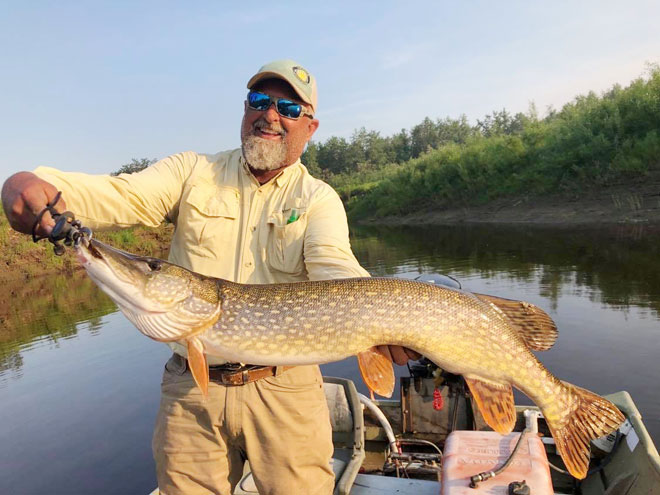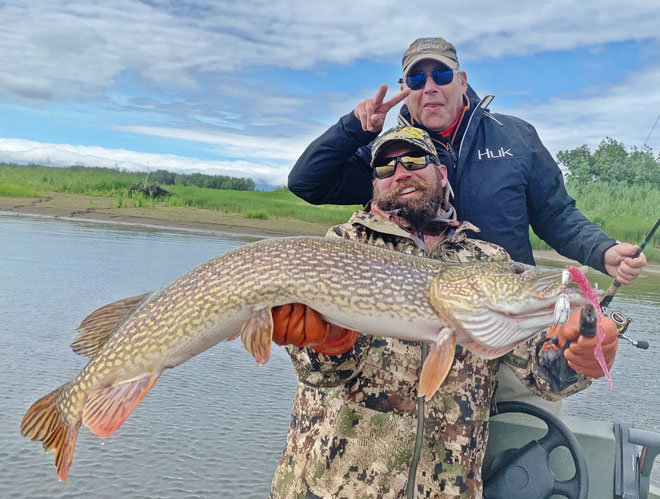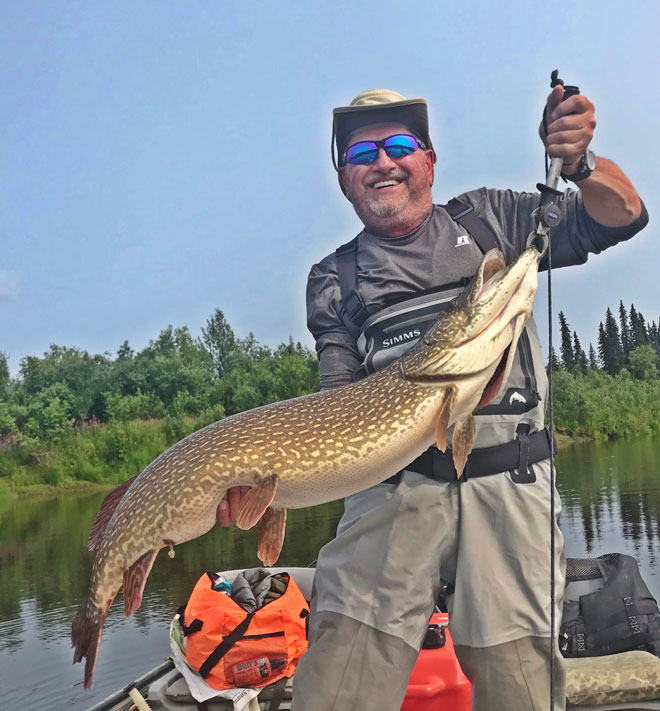Holitna River Pike
Blog and photos by Dan Paull

Giant pike are found in sizable numbers on the Holitna River. © Dan Paull
Alaska pike fishing on the Holitna River is in my opinion a sleeper of a gem. Pike fishing in Alaska is a bit of a foreign concept. When most people think of pike fishing, I’m sure Canada is the first place that comes to mind. Keep in mind, Alaska is the land of GIANTS!
Alaskan Adventures sits on the banks of the Holitna River, 237 miles west of Anchorage in the heart of bush Alaska, and we can get you into some seriously good Alaska pike fishing. We have a main lodge and several cabins on the banks of the Holitna River and pike are literally a cast away from your front porch.
The Holitna River has an overabundance of northern pike. Targeting them either with gear or on the fly, Alaskan Adventures knows where, how and what to use to constantly put fish over 40” on the end of your line.

Huge pike like this produce an explosive strike and lots of grins on angler’s faces. © Dan Paull
Our favorite time of the year for Alaska pike fishing is late spring into early summer. Pike are HUNGRY! They are just coming out of a long winter and the warm waters are heating up their metabolism, encouraging these toothy predators to put on the feed bag. This time of the year the water levels are high, and high enough to the point that our oxbow lakes adjoining the river are full and high. During this time, pike are found in the shallows way up under the flooded trees looking for frogs, baby ducks and even full-grown ducks. Yes, they are that aggressive.
When fishing these oxbow lakes, your guide will gently row the edges of the lake keeping you within casting distance of shore. It’s not uncommon to have several pike chase your offering right to the edge of the boat. It’s also not uncommon to have large, aggressive pike take your lure once it has left the water at the edge of the boat. YES, THEY ARE THAT AGGRESSIVE!
When Alaska pike fishing during this time of year, these apex predators are willing to take almost anything you throw at them, and our favorite lure is almost anything that is on the surface. From buzz baits to poppers, anything that makes a splash or disturbs the water surface really rings the dinner bell for these fish. We have seen pike come to attack from as far as 20 yards away and we have seen pike literally attack each other to beat out competition before grabbing a popper.

Pike in the 40- to 50-inch class can weigh 20- and even 30 pounds. They are very fun to fish for and catch. © Dan Paull
When Alaska pike fishing with a fly, we sometimes use flies that are close to 12” long with a very large profile. While the guide rows you down the shoreline, it’s best to slap your fly on the water’s surface as hard as you possibly can and make the biggest splash you can, and then strip it as hard as you can three- or four times. If anyone is home, they usually will come out to pounce once the water has been disturbed. When we are fishing poppers, we use the biggest popper flies we can find. Big fish like big baits and even the little ones will grab a fly twice their size.
MORE: Sheefish at Alaskan Adventures Lodge
As summer progresses, the oxbow lakes either dry up or become too warm for the fish and they move to the main river. Pike are not like salmon, trout or even sheefish. Pike like almost dead water that is barely moving or with very little current. During summer months our river system grows long, expansive weed beds in the slacker waters of the river. This is a great place to target when Alaska pike fishing. Although you can still catch them on topwater we typically start using spinners, spoons and sinking flies. Pike are still very aggressive this time of the year and as a matter of fact this past season we saw a 20” immature king salmon in the throat of about a 30” northern pike. It seems like if they can get their lips on it then it goes into their belly.
In the summer, Alaska pike fishing with flies is still a great time as we transition from topwater to a little bit heavier fly. Flies that can get down in the water column to roughly 2- to 4 feet below the surface are the ticket. Anything that looks like it’s alive will draw a strike. Pike don’t care as they eat anything, and I mean ANYTHING! Put some movement on it and make it flashy and it will get destroyed!
Once August rolls around, pike have definitely moved into deeper water. You can still find a few on the weed beds, but the majority of them have moved to the deeper, slower sections of the river. Often when Alaska pike fishing, we have looked down to the bottom of these deep holes only to see it lined with whitefish in the 12-18” range and all along the edge, pike are picking off what they can. Fall is for sure a time when the big fish are deep and going after them is definitely not quite as much of a visual experience, however the reward can be big. Some of our biggest and most consistent big fish come in the fall and all of it is fishing deep. It’s taken several years to find the best deep holes for landing monsters, but the guides at Alaskan Adventures know exactly where to look.
If you’re looking to learn how to fly fish, then pike are a great gamefish to learn with. In the early season they are really aggressive, and you don’t need to make a perfect cast to get to the fish. Often when learning to fly fish, we get frustrated when we are not successful. Well, when Alaska pike fishing on the fly, that is something you rarely will ever have to worry about. Our guides will have you casting to the fish in no time and you will be landing many fish in a day’s time. All this from the comfort of the lodge setting, private cabins and great boats to get you to the fish and back.
Dan Paull is the owner of Alaskan Adventures on the Holitna River and specializes in guided fishing, lodging and dining for guests who want to target salmon, Arctic sheefish and northern pike.


